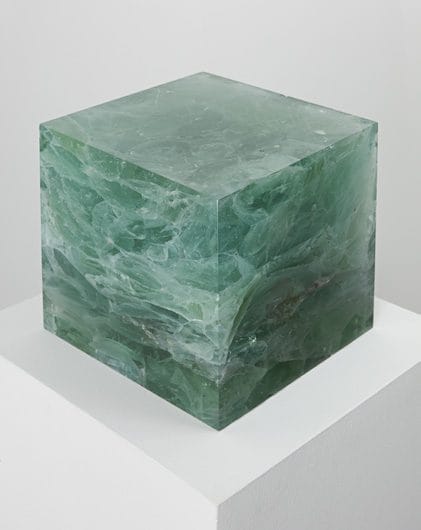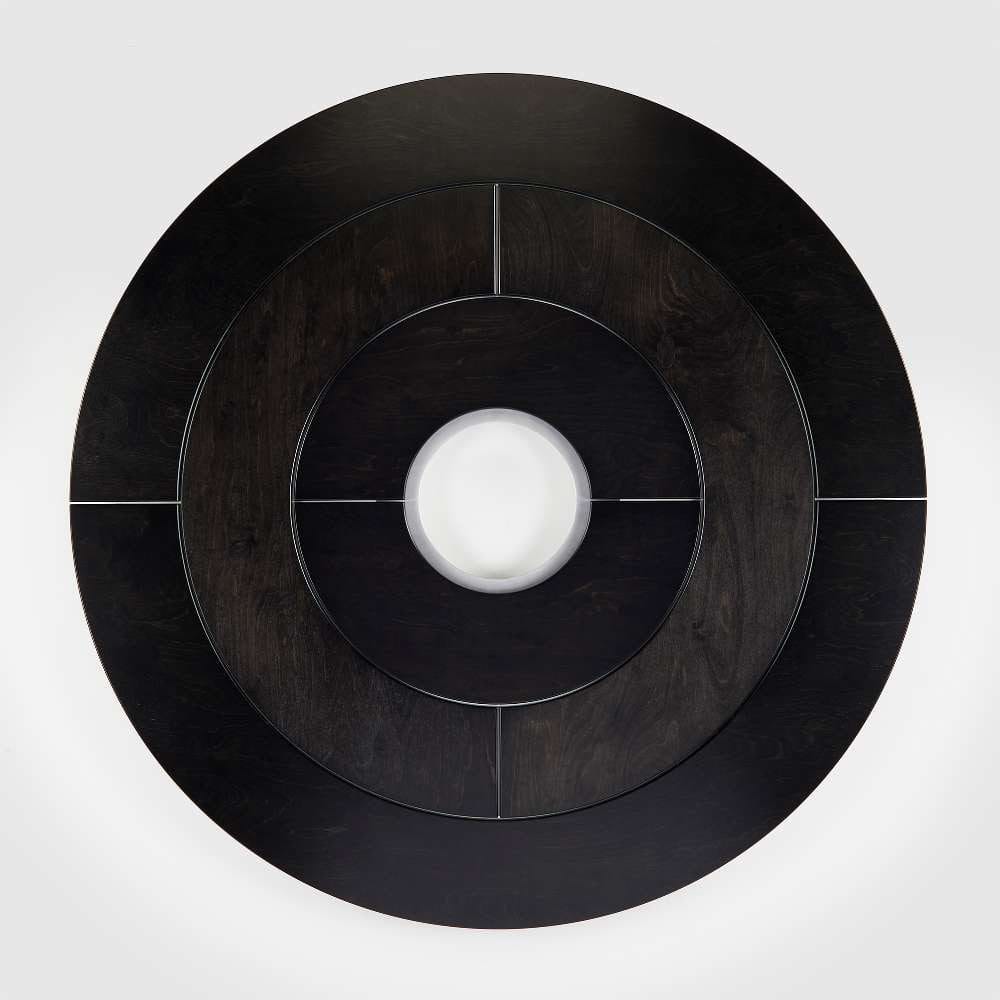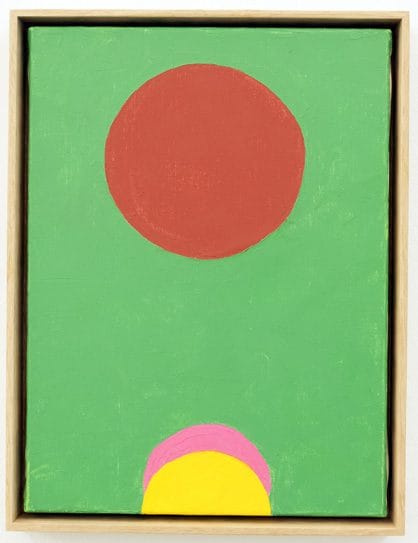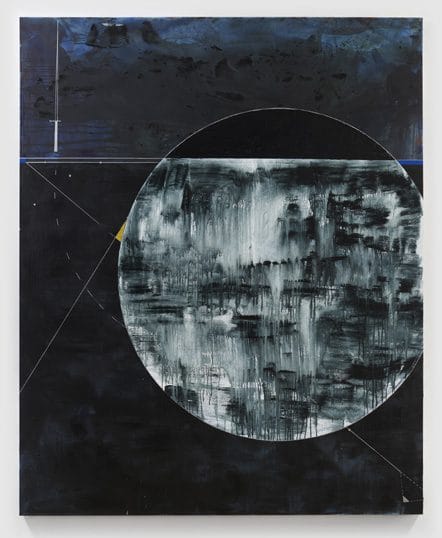New York — Pace Gallery is pleased to present a group exhibition that looks at the ways in which a wide range of artists from the early 2000s to present day use the language of minimalism and abstraction to distill complex subjects into forms that reveal new frameworks of meaning, revelation, and resistance for the here and now. Curated by Senior Director and Curator Andria Hickey, the exhibition spans two floors of Pace’s gallery at 540 West 25th Street and brings together 17 international artists from within and beyond the gallery’s program, including: Etel Adnan, Yto Barrada, Aria Dean, Simon Denny, Torkwase Dyson, Sam Gilliam, Suki Seokyeong Kang, Kapwani Kiwanga, Alicja Kwade, Tony Lewis, Rodney McMillian, Trevor Paglen, Walid Raad, Adrián Villar Rojas, Hito Steyerl, Rayyane Tabet, Jessica Vaughn, and Fred Wilson. Showcasing a wide range of media as well as outdoor sculpture, Hiding in Plain Sight examines new modes of abstraction that hold references to specific histories, entities, and contexts within the formal dimensions of the work. Like vessels that carry information from one site to another, the artworks in this exhibition manifest the complexity of modern life in forms that conceal their subject matter through aesthetic intervention.

Over the course of its 60-year history, Pace Gallery has presented thematic group exhibitions that have taken stock of the evolving relationship between form and content as articulated by each new generation of artists. These include such important exhibitions as Grids (1979) and Logical Conclusions (2005), which explored the systems and strategies of minimalism in the 1960s through the early 2000s, and the groundbreaking exhibition Blackness in Abstraction (2016), curated by Adrienne Edwards, which examined Blackness as a powerful, evocative, and animating force in abstract art from the 1940s to the present day. Building on the legacy of these important exhibitions, Hiding in Plain Sight suggests new active relationships between form and content in the ways artists interpret and express meaning today.

The artists included in the exhibition often begin their work with a process of research that explores subjects from a seemingly disparate range of sources, revealing unexpected narratives and a circuitous web of historic, infrastructural, or geopolitical connections that are often hidden in plain sight. Distilled and abstracted, this information is mapped within the formal and material dimensions of each work, such as the scale, shape, color, or form. Upon close inspection, the works bear alternative readings that position the subject matter, and the object itself, as a site for the contemplation of a fragmented and complex experience of global life today. Seemingly opaque, the artworks are encrypted with allusions to a multitude of subjects—from the extraction of raw materials and industrial production processes, to the psychological impact of color, and geometries that reflect the infrastructures of racial capitalism and trauma.

For example, Trevor Paglen’s Trinity Cube (2017) is deceptively elemental in form, yet on closer inspection its materials speak volumes. The composition of the cube references the irradiated glass of the Fukushima Exclusion Zone in Japan, and trinitite, the mineral created when the United States detonated the world’s first atomic bomb near Alamogordo, New Mexico, in 1945, heating the desert’s surface to the point where it turned sand into a greenish glass. Bringing these materials together in a single form, Paglen’s work maps sublime connections between two distant sites of disaster and discovery, surveillance and control. Similarly, Rayyane Tabet’s Steel Rings (2013— ongoing), installed on the second-floor terrace of the gallery, evokes the language of minimalism; however, the object functions as a surrogate for a specific place, time, and corporate entity. Replicating the steel rings of the Trans-Arabian Pipeline, a form of infrastructure shaped by the borders of five political entities across the Middle East, each steel ring is the same diameter and thickness of the original pipeline, engraved with the distance from the pipe’s source and its corresponding geographic coordinates, and representing a single kilometer in the 1213 kilometers of the pipeline’s convoluted journey through fraught geopolitical territories.

Kapwani Kiwanga’s exploration of color in her series Linear Paintings, of which four are included in the exhibition, suggests a relationship to the chromatic painting of Imi Knoebel or Blinky Palermo. However, these paintings on drywall depict the two-tone color palettes used in public institutions for specific psychological impacts. Creating connections between late 19th-century hygiene movements and hospital reforms, along with the color theory of Faber Birren, which has been employed in spaces of work, learning, surveillance, healing, and care, Kiwanga’s linear divisions of color reference sites of institutional control that utilized such theories to police social divisions and maintain power structures. Other artists in the exhibition navigate abstraction as a subjective space for remapping traumatic histories. Torkwase Dyson’s paintings and sculptures explore the spatial and geometric conditions of extraction in the Anthropocene. Transforming the architectonics of containment and control into planar fields and shapes of resilience delineated by horizon lines, Dyson’s paintings use shape, material and form in ways that reflect the racial conditions of extraction to build a new aesthetic foundation for abstraction.
Themes of absence, apparition, and archaeological time are reflected throughout the exhibition. Hito Steyerl’s video installation How Not to be Seen: A Fucking Didactic Educational .MOV File, 2013, echoes throughout the first floor of the exhibition, offering visitors five lessons in invisibility. Examining the circulation of images and the nature of infrastructure in the Information Age, Steyerl’s installation wryly maps formal, symbolic, and real connections between the worlds of art, economics, and global political regimes. Like Steyerl’s instructional video, the works throughout the exhibition chart unexpected but real connections between art’s formal attributes and the global infrastructures that characterize contemporary life.
Like the invisible systems and transactions in daily life, the works in this exhibition suggest that the practice of distilling and abstracting information in contemporary art echoes the mechanisms of global infrastructural space. In contrast to highways and telephone lines, core infrastructure today, such as broadband internet and global supply chains, is hidden in plain sight, concealing the perpetual circulation of information and goods in its very structure. These artworks similarly carry and conceal information but for different ends. Transcripts hidden within the visual poetics of each work suggest latent modes of resistance, revealing unseen connections buried in the infrastructural space of both the past and present. Embodied in the physical material of the artwork, social and historical events, people, and issues span time and space to create encounters in the here and now. By embracing opacity, as Édouard Glissant has suggested, these works offer an “infinite variety” of poetic landscapes in response—nonlinear, contradictory and active in the creation of new forms of interpretation and meaning.
Pace is a leading international art gallery representing some of the most influential contemporary artists and estates from the past century, holding decades-long relationships with Alexander Calder, Jean Dubuffet, Barbara Hepworth, Agnes Martin, Louise Nevelson, and Mark Rothko. Pace enjoys a unique U.S. heritage spanning East and West coasts through its early support of artists central to the Abstract Expressionist and Light and Space movements.
Since its founding by Arne Glimcher in 1960, Pace has developed a distinguished legacy as an artist-first gallery that mounts seminal historical and contemporary exhibitions. Under the current leadership of President and CEO Marc Glimcher, Pace continues to support its artists and share their visionary work with audiences worldwide by remaining at the forefront of innovation. Now in its seventh decade, the gallery advances its mission through a robust global program—comprising exhibitions, artist projects, public installations, institutional collaborations, performances, and interdisciplinary projects. Pace has a legacy in art bookmaking and has published over five hundred titles in close collaboration with artists, with a focus on original scholarship and on introducing new voices to the art historical canon. The gallery has also spearheaded exploration into the intersection of art and technology through new business models, exhibition interpretation tools, and representation of artists engaging with technology.
Today, Pace has nine locations worldwide including London, Geneva, a strong foothold in Palo Alto, and two galleries in New York—its headquarters at 540 West 25th Street, which welcomed almost 120,000 visitors and programmed 20 shows in its first six months and an adjacent 8,000 sq. ft. exhibition space at 510 West 25th Street. Pace was one of the first international galleries to establish outposts in Asia, where it operates permanent gallery spaces in Hong Kong and Seoul, as well as an office and viewing room in Beijing. In 2020, Pace opened temporary exhibition spaces in East Hampton and Palm Beach, with continued programming on a seasonal basis. In fall 2021, Pace will continue to expand its European presence with the opening of a larger gallery space in London.








